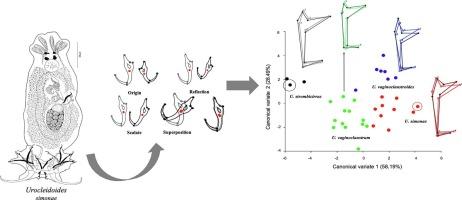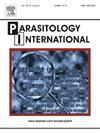寄生于墨西哥南部新热带河流中鱼类的 Urocleidoides spp.
IF 1.5
4区 医学
Q3 PARASITOLOGY
引用次数: 0
摘要
单齿目动物附着器官的形态是进行分类评估、了解生态学和进化史的重要证据来源。研究表明,触角附着器官的几何形态计量分析可提供有关单纪动物形态的丰富而精确的信息。在本研究中,我们研究了寄生于墨西哥南部新热带河流中的 Poeciliidae、Profundulidae 和 Characidae 鱼类的三个单系类 Urocleidoides 物种:U. simonae、U. vaginoclaustrum、U. vaginoclaustroides,以及现生种 U. strombicirrus。我们的目的是找出新的形态特征,用于更准确地描述这些种群,并检验这些特征是否存在地理变异。我们使用几何形态计量学方法生成了锚形体数据(n = 69)。我们使用形状数据的主成分和典型变量分析来区分物种。结果表明,存在明显的种间差异。四个物种贡献了四个新的形态特征:锚点长度、短锚根与长锚根、细长锚根与宽锚根、内根与外根的相对长度。与 Urocleidoides spp 的种间锚形变异相比,种内变异相对较低。 这些新的形态特征可能也有助于划分 Monogenea 中的其他类似物种。本文章由计算机程序翻译,如有差异,请以英文原文为准。

Shape variability and morphological discrimination of haptoral attachment structures in Urocleidoides spp. Mizelle et Price, 1964 (Monogenea: Dactylogyridae) parasitizing fish from neotropical rivers in southern Mexico
The morphology of attachment organs in Monogenea is an essential source of evidence for taxonomic assessments and understanding of ecology and evolutionary history. It has been demonstrated that geometric morphometry analysis of the haptoral attachment organs provides rich and precise information about monogeneans morphology. In this study, we consider three monogenean species of Urocleidoides, U. simonae, U. vaginoclaustrum, U. vaginoclaustroides, and the incertae sedis species U. strombicirrus that parasitize fish of the Poeciliidae, Profundulidae and Characidae in neotropical rivers in southern Mexico. We aimed to identify new morphological characteristics that can be used to describe these populations with greater certainty and to test whether these characteristics present geographic variation. Anchor shape data (n = 69) were generated using geometric morphometric methods. We discriminated species using principal components and canonical variate analysis of shape data. Our results showed that there was discernible interspecific variation. The four species contributed four new morphological characteristics: anchor point length, short versus long anchor roots, elongated versus wide anchor shape, and the relative length of inner versus outer roots. Intraspecific variation was relatively low compared to interspecific anchor shape variation in Urocleidoides spp. These new morphological characteristics may also be useful for delimiting other similar species in Monogenea.
求助全文
通过发布文献求助,成功后即可免费获取论文全文。
去求助
来源期刊

Parasitology International
医学-寄生虫学
CiteScore
4.00
自引率
10.50%
发文量
140
审稿时长
61 days
期刊介绍:
Parasitology International provides a medium for rapid, carefully reviewed publications in the field of human and animal parasitology. Original papers, rapid communications, and original case reports from all geographical areas and covering all parasitological disciplines, including structure, immunology, cell biology, biochemistry, molecular biology, and systematics, may be submitted. Reviews on recent developments are invited regularly, but suggestions in this respect are welcome. Letters to the Editor commenting on any aspect of the Journal are also welcome.
 求助内容:
求助内容: 应助结果提醒方式:
应助结果提醒方式:


